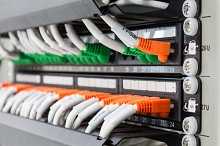28 school districts in Michigan leverage their cumulative power to provide bargain-priced internet access to Oakland County.
 As an early adopter of the “county-wide internet” concept, the School District of the City of Pontiac in Michigan pays less than a third of the statewide average for its high-speed, highly reliable internet.
As an early adopter of the “county-wide internet” concept, the School District of the City of Pontiac in Michigan pays less than a third of the statewide average for its high-speed, highly reliable internet.
Pontiac is just one of the 28 Oakland County schools districts that have hooked into the ONE consortium, which pools its collective resources to bargain big with telecom providers and tap into other funding sources. The consortium is part of a statewide Technology Readiness Infrastructure Grant (TRIG) effort that’s partially funded through the federal E-rate program.
“The state used an E-rate bid for internet… and wound up saving money across the state,” says Jeff Mozdzierz, Pontiac’s director of field services for Oakland Schools (of which Pontiac is one of 28 districts that together serve 200,000 students in 425 connected buildings).
Through ONE, the internet is provided over consortium-owned private fiber into a connection with telecom providers, with all consortium members sharing two 10 Gigabit connections. According to Tammy Evans, chief technology officer for Oakland Schools, the county was an early adopter of the concept of “shared internet” across multiple, geographically-dispersed schools. In 2000, the county rolled out a 36-connection network that links all local public school districts and its technical campus sites.
Prior to that rollout, the districts were using dialup phone modems. “When we went to a fiber network we experienced tremendous increases in capacity, speed, reliability, and the ability to share our applications and content,” recalls Evans. In 2000, the county kicked off its fiber initiative with a 250MB connection. Fast-forward to 2015 and Oakland Schools currently acts as a provider to 28 local districts via the ONE consortium and it relies on two different private vendors to supply access from two different locations. “That give us the ability to do load-balancing and have redundancy on those connections,” says Evans, “which have a total of 20 gigabits of service.”
Next page: Leveraging economies of scale
The Economies of Scale
Providing internet across all of its schools allows Oakland County to enjoy the economies of scale and other benefits.
According to Evans, the county pays about $1.40 per MB of internet access—compared to a statewide average price of about $5.00 per MB.
She says the network is reliable and up and running 99.999 percent of the time (a “five nines” in technical speak). “We have very little downtime,” says Evans, “and when the system is down it usually involves an isolated piece of equipment (or, a vehicle accident or ‘squirrel chew’ that impacts the fiber line) and we can quickly swap it out.”
Yet another reason why network downtime is minimal, says Mozdzierz, is due to the county’s use of two different providers. This allows for switching from one circuit to the other in the event of a problem and/or a network failure. “When we have a problem, we move over to the other circuit,” he says, crediting the consortium with enabling this capability.
“As a local school district operating independently, that would be very difficult to replicate, but we’ve been able to work as a group to drive the cost down and increase reliability county-wide.”
Additionally, Evans says being able to scale up internet access easily and affordably has allowed the districts to keep up with the demands of an increasingly tech-oriented educational environment. “The demand for streaming video, web delivery, and other bandwidth-intensive applications has really grown—not to mention the number of devices that each district is now using in their buildings,” Evans points out. “Through it all, we’ve been fortunate enough to pay the same rate while continuing to increase our bandwidth (thanks, in part, to the ‘competitive nature’ of the telecom industry in the region).”
Next page: Plans for inter-building connections
Of course, as with any technology implementation, there is room for improvement. From a technical perspective, for example, Evans says she’d like to see centralized firewalls incorporated into the network as a way to prevent denial of service attacks. “These are concentrated attacks on bandwidth that take specific IP addresses out of commission,” says Evans. “Any steps we can take on the security side to prevent these problems would help the consortium as a whole.”
Inter-building connections
As the county continues to hone ONE’s network security and address other issues that come up, Mozdzierz says that last year Pontiac SD submitted an E-rate request for Internet connection installations “between buildings” at the district, which currently lacks a private fiber network. Instead, the district contracts with Comcast to provide those building connections.
Because the district has a high percentage of students taking advantage of free and reduced lunch options, it leverages significant discounts through FCC’s E-rate universal service refund program. “We basically apply every year for certain services, including the internal connections that we applied for in 2014,” says Mozdzierz. “It’s an annual process so everything is in the works now, with the final release window in March or April.”
Bridget McCrea is a contributing writer for eSchool News.
- TC- What student choice and agency actually looks like - November 15, 2016
- What student choice and agency actually looks like - November 14, 2016
- App of the Week: Science sensor meets your smartphone - November 14, 2016

